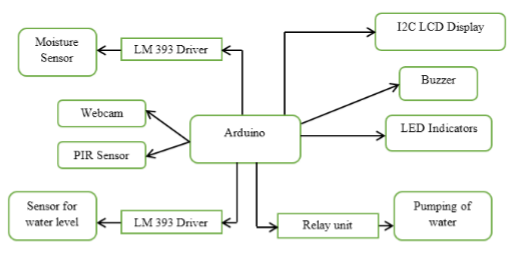Design of Security Surveillance and Automatic Water System for Agriculture
Keywords:
Arduino, Sensors, automatic irrigation, Moisture ContentAbstract
As automation technology progresses, life becomes simpler and easier in every manner. Automatic systems outnumber manual methods in today's world. The automatic system is a developing system of daily objects, ranging from industrial machines to consumer items that can execute duties. The same automation when introduced in agriculture activities will helps farmers in getting good crop. The farmer's dependency on the seasons reduces productivity and constitutes a barrier to the achievement of the food self-sufficiency strategy. Some framers who are involved in mango, guava farming has theft of crop. To solve the problem, an agricultural instrument based on information and communication technologies is required. The goal of this work was to create a programmable microcontroller chip that could regulate irrigation autonomously and also provide security by capturing and storing the data of the persons visiting the filed. An arduino microcontroller is programmed to sensor the moisture level of plants at a specific point in time; if the moisture content is less than a predetermined threshold based on the specific plant's water requirement, the necessary amount of water is delivered until it passes the threshold. Farmers did not have to irrigate their crops by hand and can also check the saved data of on filed trespassers, this helps farmers to identify the persons in case of crop theft.
Downloads
References
AQUASTAT. (2016). Water Uses. Retrieved from http://www.fao.org/nr/water/aquastat/ water_use/index.stm
Flörke, M., Kynast, E., Bärlund, I., Eisner, S., Wimmer, F., & Alcamo, J. (2013). Domestic and industrial water uses of the past 60 years as a mirror of socio-economic development: A global simulation study. Global Environmental Change, 23(1),144–156.
Sandeep Kaur and Deepali, (2017) "An automatic irrigation system for different crops with WSN", 2017 6th International Conference on Reliability, Infocom Technologies and Optimization (Trends and Future Directions) (ICRITO), Amity University Uttar Pradesh, Noida, India.
N. Siththtikumar1 and M. W. P. Maduranga, 2016, "Designing and Implimenting an Arduino Based Low Cost Automated Water Irrigat ion System for Home Gardens", International Research Symposium on Engineering Advancements (IRSEA) SAITM, Malabe, Sri Lanka.
Devika, S. V, Khamuruddeen, S., Khamurunnisa, S., Thota, J., & Shaik, K. (2014) Arduino Based Automatic Plant Watering System. International Journal of Advanced Research in Computer Science and Software Engineering, 4(10), 449–456
Agrawal, N., & Singhal, S. (2015). Smart drip irrigation system using raspberry pi and arduino. International Conference on Computing, Communication & Automation, 928–932
P. Tapak and M. Csiba, “LoT Plant Watering,” in 2018 16th International Conference on Emerging eLearning Technologies and Applications (ICETA), 2018, pp. 563–568.
A. Selmani et al., “Multithreading design for an embedded irrigation system running on solar power,” in 2018 4th International Conference on Optimization and Applications (ICOA), 2018, pp. 1–5.
X. Li and Y. Yu, “A high accuracy temperature control system based on ARM9,” in 2011 International Conference on Electrical and Control Engineering, 2011, pp. 23–26.
M. L. G. Polpitiya, G. R. Raban, W. K. S. S. Prasanna, D. T. S. Perera, D. P. Chandima, and U. K. D. L. Udawatta, “Wireless agricultural sensor network,” in TENCON 2012 IEEE Region 10 Conference, 2012, pp. 1–6.
N. R. Patel, R. B. Lanjewar, S. S. Mathurkar, and A. A. Bhandekar, “Microcontroller based drip irrigation system using smart sensor,” in 2013 Annual IEEE India Conference (INDICON), 2013, pp. 1–5.
K. Sathish kannan and G. Thilagavathi, “Online farming based on embedded systems and wireless sensor networks,” in 2013 International Conference on Computation of Power, Energy, Information and Communication (ICCPEIC), 2013, pp. 71–74.

Downloads
Published
How to Cite
Issue
Section
License

This work is licensed under a Creative Commons Attribution-ShareAlike 4.0 International License.
All papers should be submitted electronically. All submitted manuscripts must be original work that is not under submission at another journal or under consideration for publication in another form, such as a monograph or chapter of a book. Authors of submitted papers are obligated not to submit their paper for publication elsewhere until an editorial decision is rendered on their submission. Further, authors of accepted papers are prohibited from publishing the results in other publications that appear before the paper is published in the Journal unless they receive approval for doing so from the Editor-In-Chief.
IJISAE open access articles are licensed under a Creative Commons Attribution-ShareAlike 4.0 International License. This license lets the audience to give appropriate credit, provide a link to the license, and indicate if changes were made and if they remix, transform, or build upon the material, they must distribute contributions under the same license as the original.





